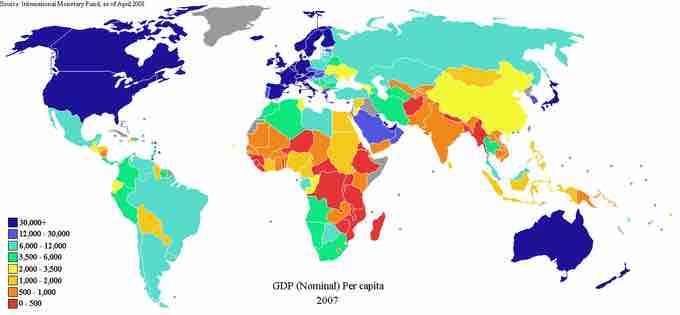Gross Domestic Product
Gross domestic product is one method of understanding a country's income and allows for comparison to other countries .

Global GDP
GDP is a common measure for both inter-country comparisons and intra-country comparisons. The metric is one method of understanding economic growth within a country's borders.
By calculating the value of goods and services produced in a country, GDP provides a useful metric for understanding the economic momentum between the major factors of an economy: consumers, firms, and the government. There are a few methods used for calculating GDP, the most commonly presented are the expenditure and the income approach. Both of these methods calculate GDP by evaluating the final stage of sales (expenditure) or income (income). However, another approach referred to as the "output approach" calculates GDP by evaluating the value of all sales and adjusting for the purchase of intermediate goods (to remove double counting).
Expenditures Approach
The most well known approach to calculating GDP, the expenditures approach is characterized by the following formula:
GDP = C + I + G + (X-M)
where C is the level of consumption of goods and services, I is gross investment, G is government purchases, X is exports, and M is imports.
Income Approach
The income approach adds up the factor incomes to the factors of production in the society. It can be expressed as:
GDP = National Income (NY) + Indirect Business Taxes (IBT) + Capital Consumption Allowance and Depreciation (CCA) + Net Factor Payments to the rest of the world (NFP)
Output Approach
The output approach is also called "net product" or "value added" method. This method consists of three stages:
- Estimating the gross value of domestic output;
- Determining the intermediate consumption, i.e., the cost of material, supplies, and services used to produce final goods or services;
- Deducting intermediate consumption from gross value to obtain the net value of domestic output.
Net value added = Gross value of output – Value of intermediate consumption.
Gross value of output = Value of the total sales of goods and services + Value of changes in the inventories.
The sum of net value added in various economic activities is known as GDP at factor cost. GDP at factor cost plus indirect taxes less subsidies on products is GDP at producer price. GDP at producer price theoretically should be equal to GDP calculated based on the expenditure approach. However, discrepancies do arise because there are instances where the price that a consumer may pay for a good or service is not completely reflected in the amount received by the producer and the tax and subsidy adjustments mentioned above may not adequately adjust for the variation in payment and receipt.